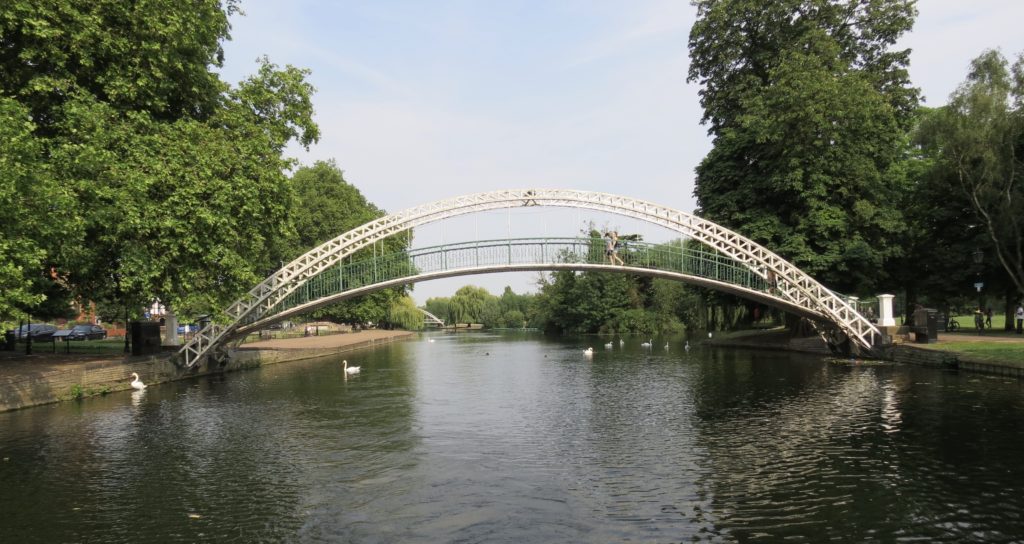
A Lost Riverside Opportunity
Having visited Bedford by car in the past, I can thoroughly recommend a visit by boat.
It’s a very interesting town however it does have a diabolical traffic problem and a significant empty shops problem, but don’t let that put you off.
The Great Ouse system, although not as internationally or historically significant as the Thames, has many similarities including ancient bridges villages and towns including Cambridge.
It also has several fascinating tributaries and ports which feed into it.
In short the Great Ouse has considerable tourist potential and Bedford could be a significant destination at the end of a large and diverse waterway network.
With the above in mind I find it extremely difficult to understand why Bedford has not fully opened itself up to the enormous financial and social benefits of waterway tourism.
When compared to other waterway regeneration projects in the UK and overseas, the lifting of two small bridges is ‘very small beer.’
Our Visit
The Great Ouse, from Bedford to Kempston Mill forms the top pound of the Great Ouse River Navigation.
Technically Kempston Mill marks the head of navigation, however in recent years river maintenance has been poor, so larger boats often need to moor just below Kempston Bridge.
At the time of our visit this upper section was quite delightful and is not to be missed.
The riverscape, of this top pound or Upper River is divided into three distinct sections.
- At Kempston Mill – Town Bridge it is almost a neglected rural stream.
- Below the Town Bridge, a monumental Broadwater is bordered on the north by an embankment and then by formal gardens and a grand carriageway, overlooked by Victorian and Edwardian redbrick villas.
The south bank of the Broadwater is formed by a series of islands and is known collectively, as Mill Meadows.
The grounds are laid to rolling parkland and it contains a boating lake and the navigations Duck Mill Lock.
This section is often referred to as the Upper River. The lock drops boats down to a low-level river channel which then runs downstream, in a cutting parallel to the Broadwater above. - Between the two contrasting landscapes the river transitions through what was the old urban town centre and docklands area. Both banks are now going through something of a regeneration.
Royal Engineers Bridge
Before craft can enter the Broadwater from the Lower River via Duck Mill Lock they need to pass under two low bridges.
The first is known as Royal Engineers Bridge, it is a pre-fabricated steel footbridge which is in need of replacement for the following reasons:
1. It does not meet modern disability standards.
2. It is not cycle or pram friendly.
3. Headroom under the bridge is only about 2130m (7′-0″) so many Cabin Cruisers are unable to reach the upper river and Bedford Town Centre.
This low headroom is hampering Bedford from benefiting from the significant tourist related benefits of being at the end of a delightful, 70 mile long navigation.
In addition to the above, Bedford plays host to the Bedford River Festival every two years.
Much of this event is held on the islands between the Upper and the Lower River.
This open air festival is the 3rd largest in the UK and Royal Engineers Bridge is now totally inadequate as a pedestrian transit route into the event from the towns south.
It is hoped that this bridge will be replaced soon.
Note:
The old rail bridge (at 7′-6″ a/d) a little way below this bridge is approximately 150 years old and also approaching the end of its economic life.

crew of German Travel Agents on board
Royal Engineers Bridge was built by the Royal Engineers as a training exercise in 1978 when the navigation was first restored by the Great Ouse Restoration Trust.
Unfortunately its low headroom makes it subject to river level variations which can make this section of river unusable at times of high river flow.
This lack of predictability has resulted in Hotel Boats omitting Bedford from their trip itineraries.
Duck Mill Lock Footbridge/service road
Adjacent to Royal Engineers bridge are the remains of an original traditional red brick arch bridge which gives access to Duck Mill Lock.
Unfortunately the original brick arch has been replaced by a flat reinforced concrete deck with timber railings which are becoming tatty.
This deck only provides a headroom of about 2100m (6′-11″) so it also presents Bedford with a similar problem to that of Engineers Bridge. See update below.
This bridge also acts as a service road for setting up the Bedford River Festival and is coming to the end of its economic life.
The reconstruction of the original brick arch would pay dividends in terms of heritage recovery, visual amenity and economic benefit to the town.

Up Date Sept 21.
This footbridge has now been re built and is no longer the lowest bridge on the river.
However, it has only been rebuilt to give a headroom of about 7′-9″ (2380m).
A truly missed opportunity.
We arrived in Bedford on a beautiful summers evening and as we rose up through the lock we were blown away by the delightful riverscape that lay before us.

The broad Duck Mill Lock is 10′-9″ (3.3m) wide which is 6″ (150mm) wider than Cardington Lk, just over a mile down stream, so no problem in regard to width.
This lock is sometimes known as Bedford Lock or Town Lock.
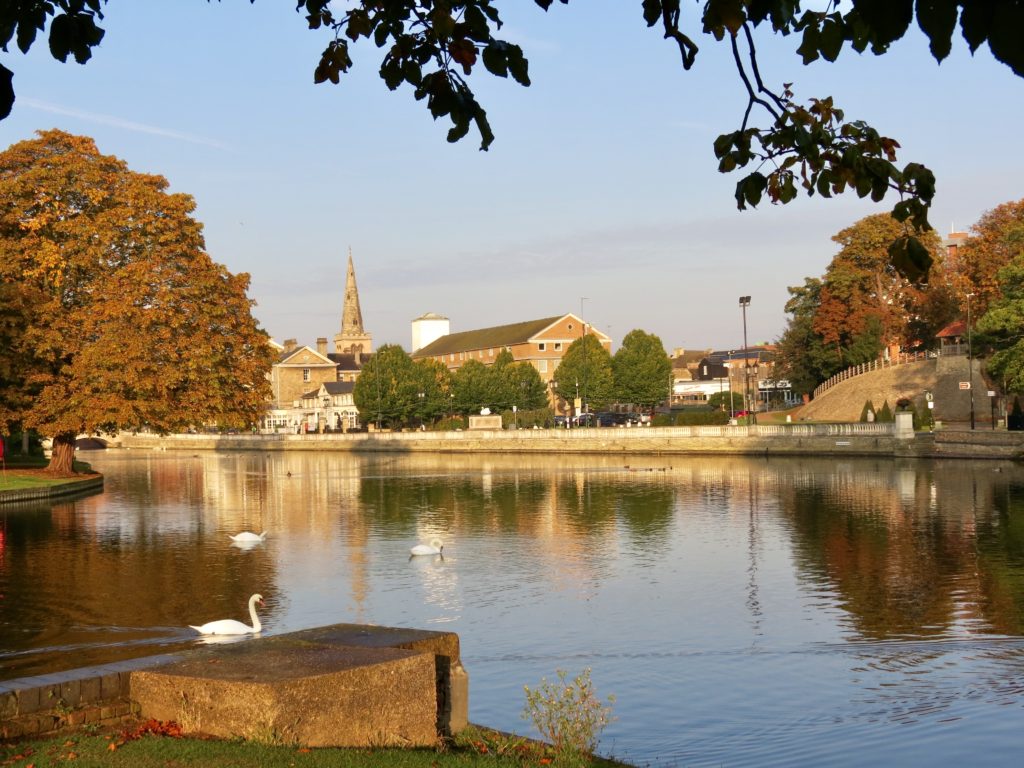
The first section of the Broadwater and its Embankment is set off by the spire of St Paul’s Church and the Swan Hotel, built for Francis, Duke of Bedford in the 18th Century as a Coaching Inn.
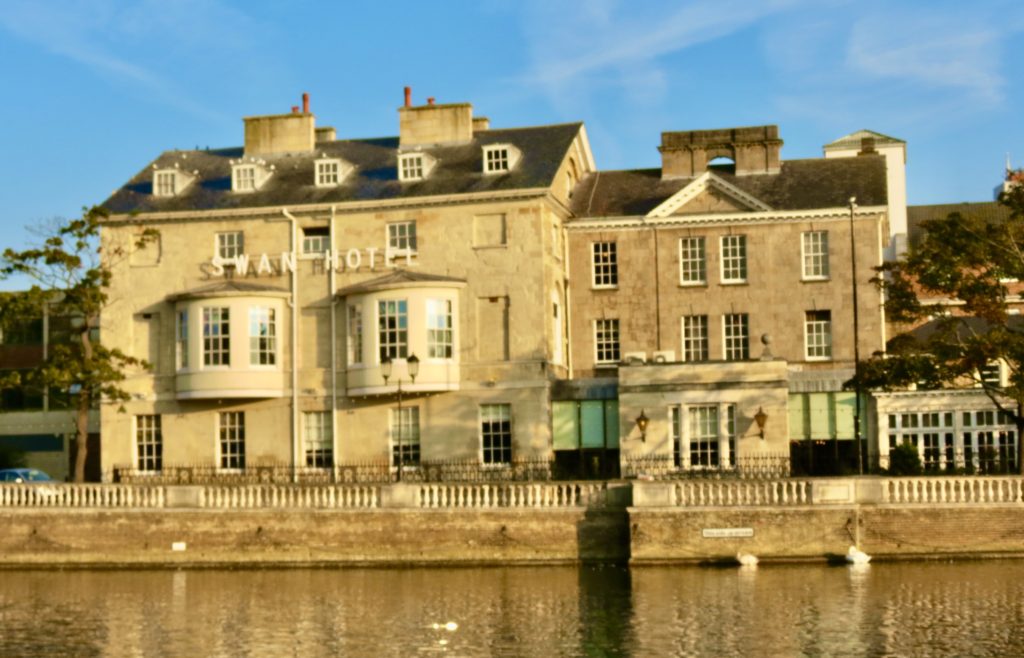
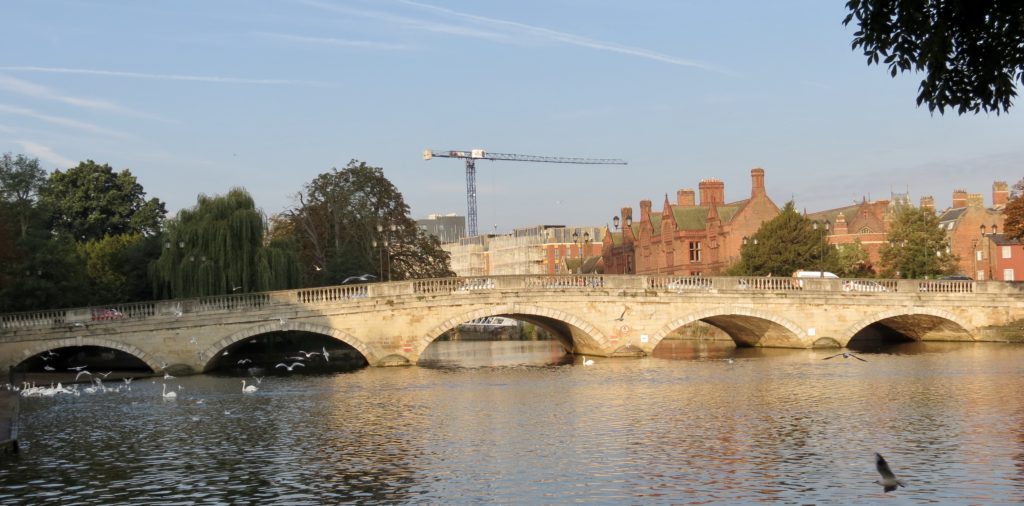
Bedford’s Georgian Town Bridge was completed in 1813 and looks much lower than it actually is. For some reason the EA bridge headroom schedule will not give any bridge headroom dimensions above Duck Mill Lock.

The newly created riverside path can be seen in the background
The new Town Centre footbridge and riverside path were built in response to criticism revolving round a lack of connectivity between the towns retail area, the waterside and the South Bank which contains Bedford College.
The new bridge is very controversial as the locals feel it bears virtually no resemblance to the design which was chosen by them after numerous consultations. The bridge also has little weather protection in what locals consider to be a very exposed location.

After passing under the new footbridge we moored up at the official town moorings which are tucked behind a small island.
They also have a water point at one end.
The moorings are extremely convenient for the retail centre of the town and railway station.
When we moored up we had no idea that the area was at one time the town swimming pool and that the island contained the pools changing rooms.
On our second evening we were joined by a hire boat crewed by travel agents from Bremen, Germany – who were agents for Black Prince Holidays.
They were scoping out Bedford as a boating destination for their clients
back in Germany.
I am pleased to report it passed with flying colours.
Our third evening proved to be very interesting not to mention entertaining.
During dinner two polite taps on the roof led to the local Water Polo team manager introducing himself to us.
He was in fact, good humouredly claiming existing user rights on the pool. He suggested that we move our boats up the path a little so they could play Polo without fear of interfering with our enjoyment.
Needless to say we both acquiesced and were treated to an evenings sporting entertainment.
Our new German friends were most amused.
The following morning we picked up two boating friends who are unable to bring their cruiser on to the Upper River due to its headroom and we all proceeded upstream under the two low railway bridges for lunch at Kempston Mill.
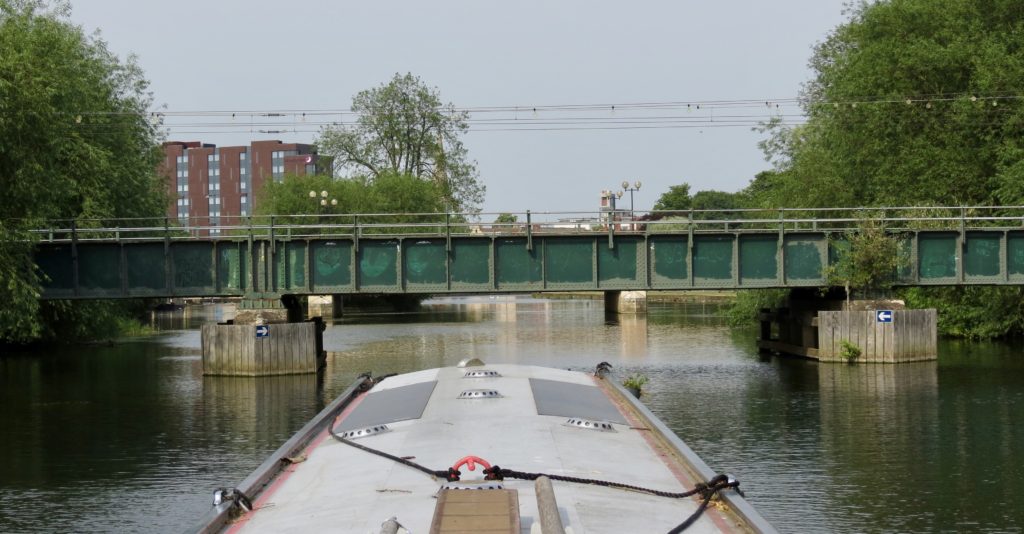
First Rail Bridge above Bedford
Both rail bridges have a headroom of about 7′-00″ (2100) depending on river levels.
For boaters on the Grand Union who are interested in a visit to Bedford, the moorings above Fenny Stratford Lock give easy access to its station.
It is then only a short ride into the centre of Bedford for a days exploration.
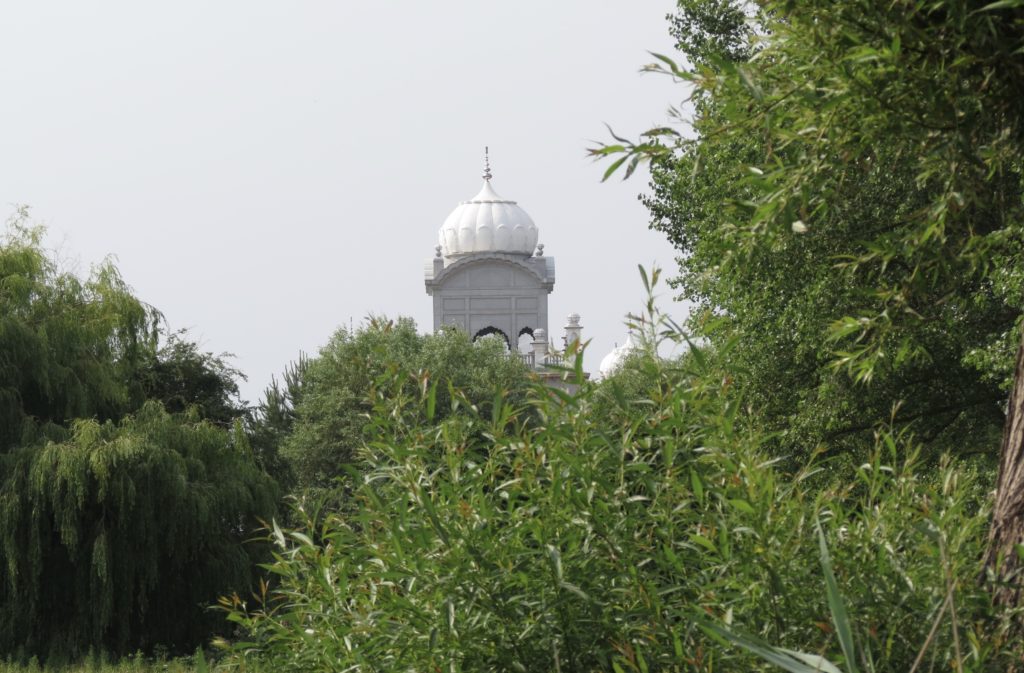
After passing the rail bridges the river becomes totally rural with only the top of the towns Gurdwara poking through the tree line.


We surmised that the few navigation buoys in the river had been set by the BMK Trust.
Although the river can be very intimate in some locations, the BMKT Broad Beam Trip Boat ensures there is plenty of room for narrow boats up to Kempston Mill.


Kempstone Mill Footbridge gives access to the weir island
Due to a lack of river maintenance this had to be our mooring and the limit of our trip on this visit.
We understand the BMKT have now cleaned out the area so their trip boat can get to the bridge and moor.
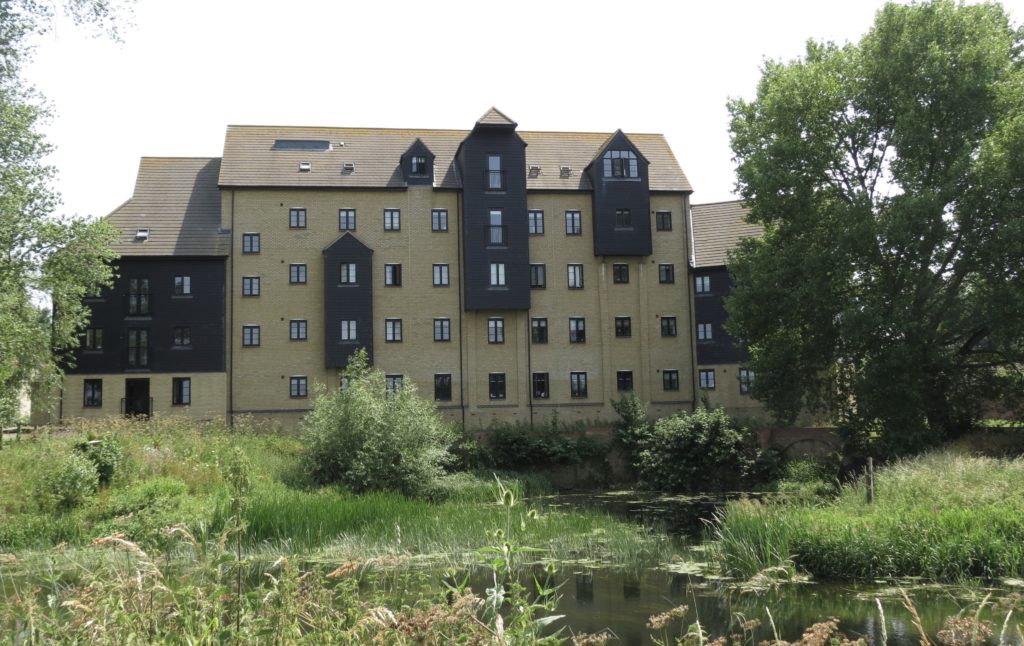
The last mill on the site closed in 1968 and burnt down in 1969 when the owner was overseas.
The buildings which now occupy the area are all part of a totally new residential development.

It is anticipated that the new BMK Link canal will commence somewhere just up stream of this area.
After a very pleasant few hours exploring the river and footpaths in the area we returned to Bedford without incident.

The 2nd Bridge above Bedford
In addition to Bedfords attractions it is a very easy rail trip to Bletchley from Bedford and a short walk from its station brings one to Bletchley Park, a very worthwhile side trip.

By the time we got back to Bedford the rowers were out on the river.
During our stay they seemed to appear at about 4:30pm and disappear at about 6pm.
The remainder of the time the river was virtually empty.

Returning past our mooring which can just be seen under the left arch, however access should be made from down stream.

This is the new walkway area, during our visit the eateries received very little patronage. The only other boats we saw were a few sculls.
We understand small boats are now beginning to moor on the south bank so hopefully this will add more interest to the river and encourage more trade for the waterside cafes.
The Broadwater

and potential mooring site from under Town Bridge
To the front of the Swan a wide set of steps lead down to the river from the Hotels former carriage square.
Its only redeeming feature now being a Boar War Memorial confined in a somewhat forlorn and isolated paved triangle.
The remaining triangle being occupied by, unnecessary and uncompromisingly sterile roadways and traffic islands.
This is an incredibly central but neglected position.
That said, nimble boat crews can enjoy easy access to the High Street shops, restaurants, museums and adjacent gardens.
However at present mooring is not particularly practical.
The adjacent embankment wall below the balastrading of the Swan would make an excellent backdrop for short stay cruiser moorings.
Moored boats would add interest and movement to the views both to and from the embankment.
Boat crews and pedestrians moving to and fro across the square between the High Street and river could add new life to a restored and reinvigorated traffic restricted square.

Despite being a beautiful September evening by the time we returned the Rowing Club about 6:30 all was deserted.

Bedford Suspension Bridge was built in 1888 to give access to Mill Meadows which the Corporation had purchased in 1883. Its unusual form results from a need for it to allow sailing boats to pass beneath it. The first design was dismissed as it didn’t give enough room for a sail.
It is not the easiest of bridges to walk over.

for Duck Mill Lock
Several years ago consultants recommended the replacement of both Duck Mill Lk (width 10′-9″) and Cardington Lk (10′-3″) with new wide beam locks 15″-0″ (4600m) beam.
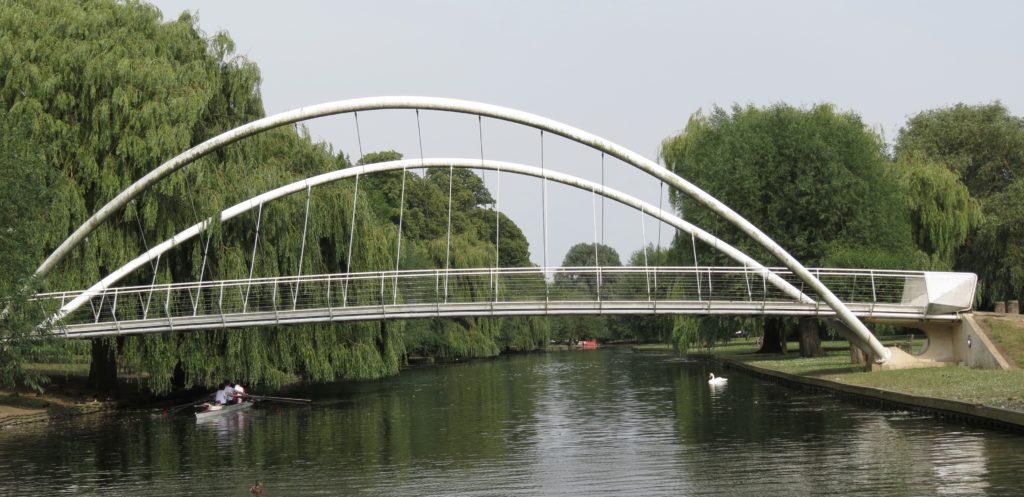
Bedfords’ Butterfly Bridge, was built in 1997 as the result of an Architectural competition run by the RIBA and the Bedford Corporation as a Millennium project. The competition received 79 entries.
The redbrick Victorian and Edwardian villas and a number of small monuments line the left bank and make an interesting Riverside walk.

The Broadwater ends at a very nice little low level reinforced concrete Art Deco footbridge glimpse, under the tree on the left.
As the channel narrowed on the bend we turned at that point.

with the low bridge in the background
As all the rowers had packed up for the evening, we had a lovely slow cruise back to our swimming pool mooring past Duck Mill Lock.
When viewed from this angle it becomes obvious how a restored red brick arch to the old bridge would transform this view.
Conclusion
Including side trips and exploring the towns Market, Museums and Gardens we spent a very enjoyable week in Bedford and would definately recommend it as a boating destination.
As a holiday hire boat destination it is only three days by boat from the university town of Cambridge.
WONDERFUL Post.thanks for share.
Admiring the commitment you put into your website and detailed information you provide.
That is really interesting,
Hello there, You’ve done a great job. I will definitely digg it and personally suggest to my friends. I’m sure they’ll be benefited from this website.
Hi there, You have done an incredible job.
Thanks on your marvelous posting! I certainly enjoyed reading it, have a nice weekend!
WONDERFUL Post.thanks for share..